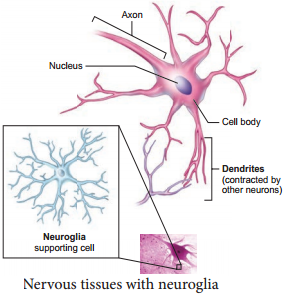Learninsta presents the core concepts of Biology with high-quality research papers and topical review articles.
Neural System Definition, Function, Structure and its Types
The neural system comprises of highly specialized cells called neurons, which can detect, receive, process and transmit different kinds of stimuli. Simple form of neural system as nerve net is seen in lower invertebrates. The neural system of higher animals are well developed and performs the following basic functions:
Sensory Functions:
It receives sensory input from internal and external environment.
Motor Functions:
It transmits motor commands from the brain to the skeletal and muscular system.
Autonomic Functions:
Reflex actions.
The nervous system is the part of an animal’s body that coordinates its behavior and transmits signals between different body areas. In vertebrates it consists of two main parts, called the central nervous system (CNS) and the peripheral nervous system (PNS). The CNS contains the brain and spinal cord.
The nervous system takes in information through our senses, processes the information and triggers reactions, such as making your muscles move or causing you to feel pain. For example, if you touch a hot plate, you reflexively pull back your hand and your nerves simultaneously send pain signals to your brain.
The central nervous system is made up of the brain and spinal cord, and the peripheral nervous system is made up of the Somatic and the Autonomic nervous systems.
The nervous system consists of the brain, spinal cord, sensory organs, and all of the nerves that connect these organs with the rest of the body.
The nervous system in a human is made of the brain, spinal cord, sensory organs and all the neurons that serve as communication channels between the various organs of the body.
The peripheral nervous system carries messages to and from the central nervous system. It sends information to the brain and carries out orders from the brain. Messages travel through the cranial nerves, those which branch out from the brain and go to many places in the head such as the ears, eyes and face.
The nervous system has three broad functions: sensory input, information processing, and motor output. In the PNS, sensory receptor neurons respond to physical stimuli in our environment, like touch or temperature, and send signals that inform the CNS of the state of the body and the external environment.
The neural or nervous system is a complex network of nerve cells or neurons. The nervous system is specialized to carry messages while the endocrine system provides chemical integration through hormones. To better understand the nervous system, one must realize the difference between a neuron and a nerve.
The Structure of a Neuron:
The above image shows the basic structural components of an average neuron, including the dendrite, cell body, nucleus, Node of Ranvier, myelin sheath, Schwann cell, and axon terminal.
The gap between two neurons called synapse, helps in quick transmission of impulses from one neuron to another. Always one-way communication i.e. unidirectional, transmitting from pre-synaptic to post-synaptic neurons. Can be used to calsculate timing of sensory inputs. Greater plasticity.
Neurons have specialized projections called dendrites and axons. The synapse contains a small gap separating neurons. The synapse consists of: a presynaptic ending that contains neurotransmitters, mitochondria and other cell organelles.
